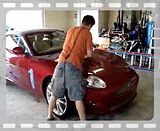I'm in the explaining mood...

Heat is not necessary, and often times unwanted, as far as polishing goes. People on here speak about heat, like if they where to warm the abbrasives in an oven, the abbrasives will some how refine themselves.
Heat is the obviously by product or reaction of friction caused between the polish, the pad, and the paint. You can some what gauge (very inaccurately) the amount of friction or "work" you are doing (paint removal) by the varing your RPM/Polish/Pad/Pressure. But no detailer I know puts his hand on the paint, accurately judges the the tempature of the paint, then factors in every variable (paint hardness, inital abbrasive aggressiveness x the rate the abbrasive breaks down, pad type, rpm, ect...) then computes this crazy equation in his head and gauges the amount of work he has done.
I think the thought of putting heat into the polish to break it down came from an old bodyshop guy, teaching some young scribe to "Really put some heat into."
As you already alluded, the rate which the abbrasive breaks down is a function of the make up of the abbrasive and the force/time which it is worked against the surface. The higher the RPM you use (increasing friction), the faster the abbrasive breaks down (thus reducing working time) but the increase in friction from the pad's great velocity plus the larger, more aggressive abrasives(haven't broken down yet, tends to make up in the reduction of time.
Generally, for polishing (removing light scratches, swirls, and burnishing the finish) the best way many have found is to light work the polish into the surface with moderate RPM's first (800-1000) for a couple passes to ensure a uniform paste of polish has been layed down on the paint. Then the RPM is brought up to speed to polish the paint quicker (the RPM you use is dependant on the amount of cut you want) until the polish is fully broken down) then often reduced and another pass or two is made to lightly burnish the surface and reduce hologramming (or negating it).
Here is a video clip of my working 106ff polish. You can see I make one quick pass to work the polish in very quickly and ensure a uniform paste of polish is one the paint, then I jump the RPM up to around 1700 or so (which is an RPM I personally like to break this polish quickly while uniformly breaking down the abbrasives) until the polish has broken down, then I back the RPM off and make one more pass to at around 1000 RPM to refine the finish and make sure it is perfect.


